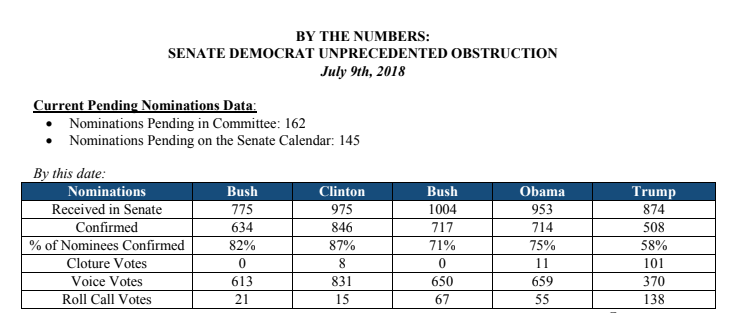On prime-time, national television, President Trump will announce his next nominee for the Supreme Court. It is a decision that highlights his legacy, shapes the judiciary for at least a generation, and overshadows what the White House describes as “unprecedented obstruction” by Senate Democrats.
While Sen. Chuck Schumer, D-N.Y., and company were powerless to slow the nomination of Judge Neil Gorsuch, Democrats have enjoyed unprecedented success in blocking Trump’s lower court nominees.
[Also read: Trump’s top four candidates to succeed Justice Anthony Kennedy on the Supreme Court]
According to a one-page White House memo obtained by the Washington Examiner, each of the last four presidents had confirmed hundreds more judicial and executive nominees than Trump by the second July of their presidency. For instance, the Senate had confirmed 75 and 87 percent of former Presidents Barack Obama and Bill Clinton’s picks by this time in their term. They have confirmed just 58 percent for Trump.

How have Democrats managed this while in the minority? The White House argues that “Schumer is weaponizing cloture.” By calling for a cloture vote (a vote to end debate officially) Democrats aren’t just blocking a single nominee – they’re ensnaring the entire Senate and limiting the number of nominees who can come up for a vote.
It doesn’t matter if they like or will even end up voting for the nominee. What matters is eating up clock.
Democrats have forced Republicans to dot every procedural I and cross every parliamentary T before getting their nominee a vote. As the New York Times reported last year, that means calling for a cloture vote which in turn requires an “intervening day” to allow the request, in parliamentary parlance, to “ripen.” After that, the rules require 30-hours of “post-cloture” debate before a final vote.
The White House points to the nomination of Fernando Rodriguez Jr. to become district judge for Texas and Robert Earl Wier to become district judge for Kentucky. The Senate ended up voting unanimously for both but not until Democrats basically made Republicans crawl inch by inch through parliamentary molasses to get to the finish line.
It is a delaying tactic and it is the best weapon Senate Democrats have in their arsenal.
While lower court nominees often go unnoticed, the Obama administration fully understood their importance. That White House managed to remake the federal judiciary in his own image eventually nominating enough liberal justices to tip control of nine of the 13 circuits of the U.S. Court of Appeals.
“The Supreme Court grabs the spotlight, but it hears fewer than 100 cases a year,” then-Texas Supreme Court Justice Don Willett told me in Sept. 2016, “while the 13 federal courts of appeals handle about 35,000.” More than one-third of the 179 judges on federal appeals courts owe their seat to Obama, according to Willett, now a justice on the U.S. Court of Appeals for the 5th Circuit and a potential Supreme Court pick. “That’s a legacy with a capital L.”
Unless Republicans amend cloture rules, it seems doubtful that Trump will enjoy the same success as his predecessor.

